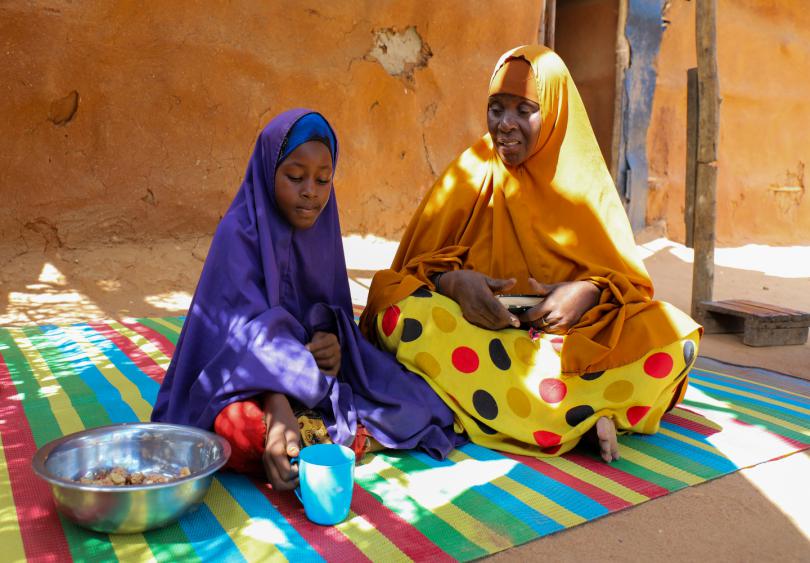FINDING HOPE IN DADAAB: ASHA’S JOURNEY OF RESILIENCE

Asha in class enjoying a lesson with her classmates. Photo Courtesy |Save the Children
By Dorothy Waweru
Asha is a lively jovial girl, the youngest in a family of five. She lives with her parents and siblings in Dadaab refugee camp. Asha and her family have lived in the camp for 16 years, having fled Somalia in 2009 after a devastating drought wiped out their cattle, leaving them without food or income.
“We came to Dadaab to escape the hunger and poverty. Relatives told us that we would find food, water, and health services at no cost here,” says Fatma - Asha’s mother. Upon arrival, they were registered as refugees by the United Nations Human Rights Commissioner for Refugees (UNHCR). The registration gave them access to essential services including food, water, medical care, and education. This significantly improved their lives.
We meet Asha and Fatma on a Tuesday morning as they prepare for school. After twenty minutes of preparation, they are ready. It is not until Asha begins to walk that you notice that she has a disability that makes her movement tiresome because her right leg is numb, and her left leg is immobile.
Despite her disability, which makes walking a challenge, her spirit is unwavering.
As such, she needs transport to get to school. Her parents spend Ksh. 3,000 monthly as a transport fee for Asha. This is quite a steep cost for them as they rely on menial jobs to earn a living. This high cost of transport nearly forced Fatma to pull Asha out of school. Fortunately, the school recommended Asha to an Alternative Basic Education (ABE) centre supported by Save the Children which was closer home and offered free transport.
“I am grateful to the ABE centre for enrolling Asha and providing transport. Since enrolling, Asha has been picked up to go to school and brought home every day.” Says Fatma.
Asha had a wheelchair but it broke. However, this did not stop her from going to school. With her mother, they improvised an assistive device to help her navigate while in school as the wheelchair gets repaired.
In class, Asha is a friend to all, teachers, and students alike. Her participation reveals her love for learning. “I enjoy environmental studies and English. When I grow up, I would like to be a teacher,” she says.
Bashir Ahmed a centre manager in Asha’s school says that the school has a population of 698 learners, 35 of whom are special needs learners.
“Out of the 35 learners with special needs, 17 are boys and 18 are girls. The entire school has 12 teachers and only one is trained. The school has a Board of Management comprising of members of the community who help us with education affairs,” adds Bashir.
At the end of the classes, children are given milk and biscuits which is a usual practice and happily, they run home. Asha is brought home using the same taxi that took her to school in the morning. Fatma welcomes her and gives her a bowl of rice mixed with beans which she eats happily.

Asha in the company of her mother enjoying a meal after school. Photo Courtesy| Save the Children
“My favourite food is spaghetti, rice and ugali. I also enjoying playing with bottles and utensils when we pretend to be our mothers or our fathers.” says Asha.
Fatma sees Asha as a bright child with a promising future. “Aside from the leg disability, she is smart and diligent.” She encourages parents with children with disabilities to allow them to get an education because that is the only way they get empowered. “I believe that Save the Children can create awareness on inclusive education throughout the refugee camp Inshaallah, I want my daughter to be a teacher,” adds Fatma.
Fatma hopes for better facilities, including a special toilet and more comfortable sleeping materials for Asha, as she is currently sleeping on an uncomfortable mat.
Fatma is grateful that all her children are in school and becoming more enlightened than she ever was. She concludes happily, "We were living in darkness back in Somalia, but now, Alhamdulillah, we have seen the light."
Save the Children with funding from the European Union Humanitarian Aid has been supporting 10 Alternative Basic Education centres in Dadaab Refugee Camp. Part of the support these centers have received includes teacher training and supporting 90 teachers with incentives, the provision of stationery such as pencils and textbooks, and tablets to enable them to boost their numeracy and literacy skills.
“The total enrolment of learners in our ABE centers stands at 4,426 learners, 141 are children with disabilities, 77 boys and 64 girls. Save the Children has been offering transport for learners with a disability to ease their movement. To motivate the learners, we also provide milk and biscuits during break time which ensures that they can concentrate in class. With more funding, we can ensure that no child with or without disability misses out on education” says Abdirahman Garane, Education Officer, Save the Children.
Save the Children is also working with a local partner Relief Reconstruction and Development Organisation is at the forefront of climate action by ensuring that the ABE centres have trees and that infrastructure is reinforced to withstand climate shocks.




